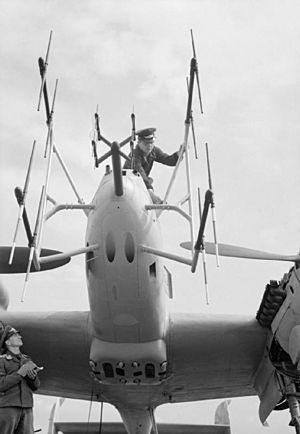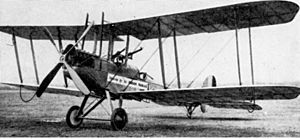All-weather fighter facts for kids

A night fighter is a special type of fighter aircraft designed to fly and fight when it's dark or when the weather is bad. These planes first appeared during World War I. They were built or changed specifically to operate at night.
During World War II, night fighters were either custom-built for night missions or, more often, were heavy fighters or light bombers that were changed for the job. They often used radar or other systems to help them find enemies in the dark. Many night fighters also had special landing systems. These systems helped them land safely at night without turning on bright runway lights, which could attract enemy planes. Some attempts were made to use regular day fighters at night, but these usually only worked in perfect conditions.
Over time, airplane electronics (called avionics) became much smaller and better. This allowed planes to have advanced tools like radar altimeters (to measure height), terrain-following radar (to fly low over land), and improved landing systems. They also got better navigation tools like LORAN, GEE, TACAN, inertial navigation system, and GPS. Because of these amazing improvements, most fighter planes could fly and fight at night. The term "night fighter" slowly disappeared as nearly all modern fighters became "all-weather" capable.
Early Night Fighters
At the start of World War I, most countries couldn't fly planes at night, and they didn't really need to. Attacking cities was not common then. Everyone thought the war would end quickly, so there was no need for long-term attack plans.
Things changed on September 22 and October 8, 1914. The Royal Naval Air Service bombed Zeppelin factories in Germany. The defenses against these attacks were very weak. By 1915, some B.E.2c planes were changed to become the first night fighters. At first, they tried using darts or small bombs to attack Zeppelins from above. This didn't work well.
Then, they tried a new method. They put a Lewis gun with special incendiary ammunition on the plane. This gun was angled upwards at 45 degrees. This allowed the pilot to shoot at the enemy from below. This new way of fighting worked very well.
After more than a year of night Zeppelin raids, a big moment happened on the night of September 2–3, 1916. A BE2c plane, flown by Captain William Leefe Robinson, shot down the German airship SL 11 over Britain. This was the first German airship shot down over Britain. For this brave action, the pilot received the Victoria Cross medal and £3,500 in prize money. This wasn't the only victory; five more German airships were shot down between October and December 1916. These losses caused the airship attacks to slow down over the next year.
Because airships had limitations, the German Luftstreitkräfte (Air Force) started using long-range heavy bombers. The Gotha G.IV aircraft began to lead the attacks. Their first daylight raids on London in May 1917 easily got past the weak defenses. But as Britain's home defense fighters got stronger, the Germans switched to night raids from September 3, 1917. To fight these night attacks, Sopwith Camel day fighters were used as night fighters.
The Sopwith Camels' Vickers guns were replaced with Lewis guns mounted over the wings. This was because the flash from the Vickers guns could blind the pilot at night. Also, synchronized guns were thought to be unsafe for firing incendiary ammunition. The cockpit was also moved backward in these modified planes. These changed aircraft were called the "Sopwith Comic." To help squadrons in northern UK, Avro 504K training planes were also turned into night fighters. They removed the front cockpit and put a Lewis gun on the top wing.
Night Fighters of World War I
- Royal Aircraft Factory B.E.2 Night fighter
- Sopwith Camel "Comic" Night fighter
- Sopwith 1½ Strutter Night fighter
- Supermarine Nighthawk
Night Fighters of World War II
Germany
- Arado Ar 68E-1
- Dornier Do 217J/N
- Focke-Wulf Ta 154
- Heinkel He 219
- Junkers Ju 88C/G
- Messerschmitt Bf 110D/F-4/G-4
- Messerschmitt Me 262 A-1a/U2, B-1a/U1
- Focke-Wulf Fw 189 A-1
- Focke-Wulf Fw 190 A-5/R11
Italy
- Fiat CR.42CN Falco
- CANT Z.1018/CN "Leone"
- Caproni-Vizzola F-5/CN
- Reggiane Re.2001CN Serie I, II, III "Falco"
Japan
- Aichi S1A Denko
- Kawasaki Ki-45 KAIc
- Mitsubishi Ki-46-III KAI
- Mitsubishi Ki-109
- Nakajima C6N1-S
- Nakajima J1N1-S
- Yokosuka D4Y2-S
- Yokosuka P1Y1-S
Hungary/Romania
- FIAT CR.42 "Falco"
- MÁVAG Héja
- Messerschmitt Bf 109F
- Messerschmitt Bf 110G-4d
- Messerschmitt Me 210Ca-1/N
Soviet Union
- Petlyakov Pe-3bis
- Yakovlev Yak-9M PVO
United Kingdom
- Douglas Havoc (US-built)
- Douglas Havoc (Turbinlite) (US-built)
- Boulton Paul Defiant Mk II
- Bristol Beaufighter
- Bristol Blenheim Mk IF
- de Havilland Mosquito NF series
- Fairey Firefly NF Mk 5
- Supermarine Spitfire
United States
- Douglas P-70
- Bristol Beaufighter (British supplied)
- Grumman F6F-3E/F6F-3N/F6F-5N Hellcat
- Lockheed P-38M "Night Lightning"
- Northrop P-61 Black Widow
- Vought F4U-2/F4U-4E/F4U-4N Corsair
France
- Mureaux 114/CN2
- Morane-Saulnier M.S. 408/CN
- Potez 631 C3/N
Post-war Night Fighters
After World War II, night fighters continued to develop with new technologies.
Canada
- Avro Canada CF-100
United Kingdom
- de Havilland Mosquito NF 36/38
- de Havilland Sea Hornet NF 21
- de Havilland Vampire NF 10/54
- de Havilland Venom NF 2/2A/3/51/54
- Gloster/Armstrong-Whitworth Meteor NF 11/12/14
- Gloster Javelin
United States
- Douglas F3D Skyknight
- Grumman F7F-1N/2N Tigercat
- Lockheed F-94 Starfire
- McDonnell F2H-2N/F-2H-4 Banshee
- McDonnell F-101 Voodoo
- North American F-86D/K/L Sabre
- Northrop F-89 Scorpion
- Vought F4U-5N/F4U-5NL Corsair/Goodyear FG-1E Corsair
See Also
 In Spanish: Caza nocturno para niños
In Spanish: Caza nocturno para niños


